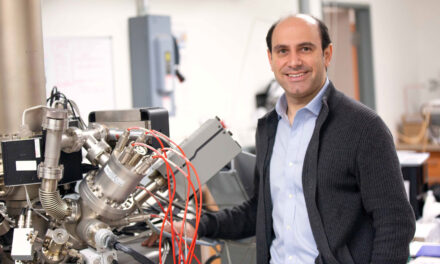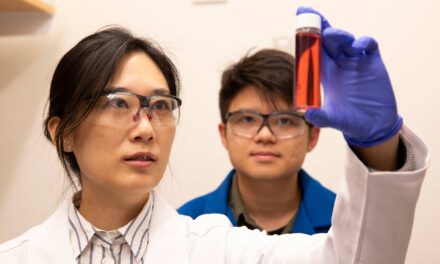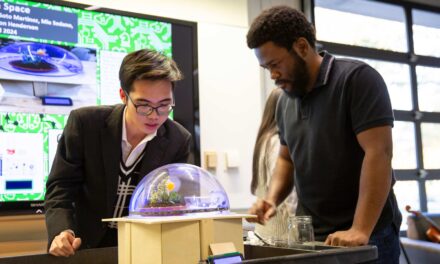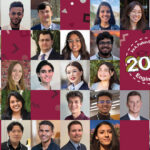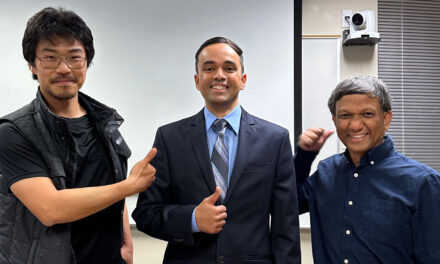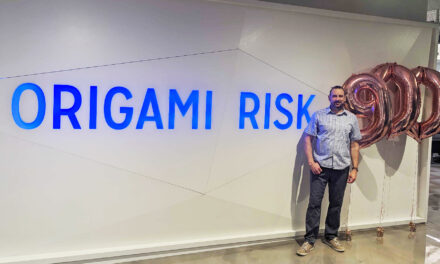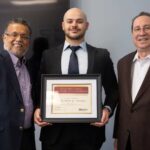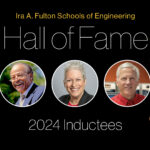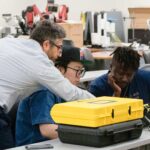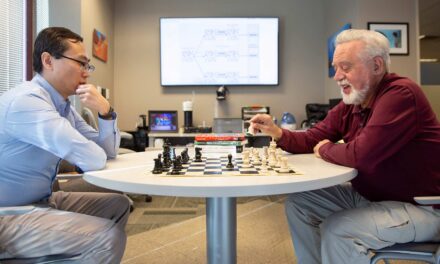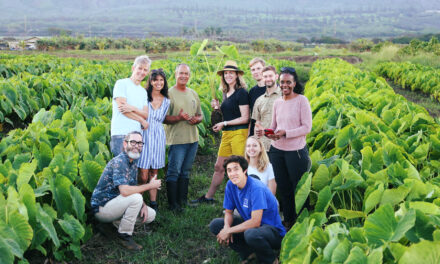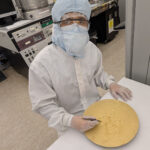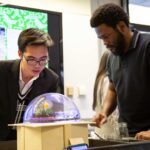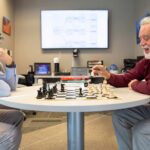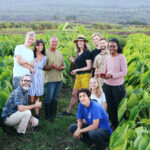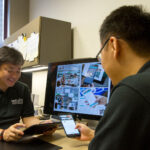
Work ethic earns professor a place in Canadian Academy of Engineering
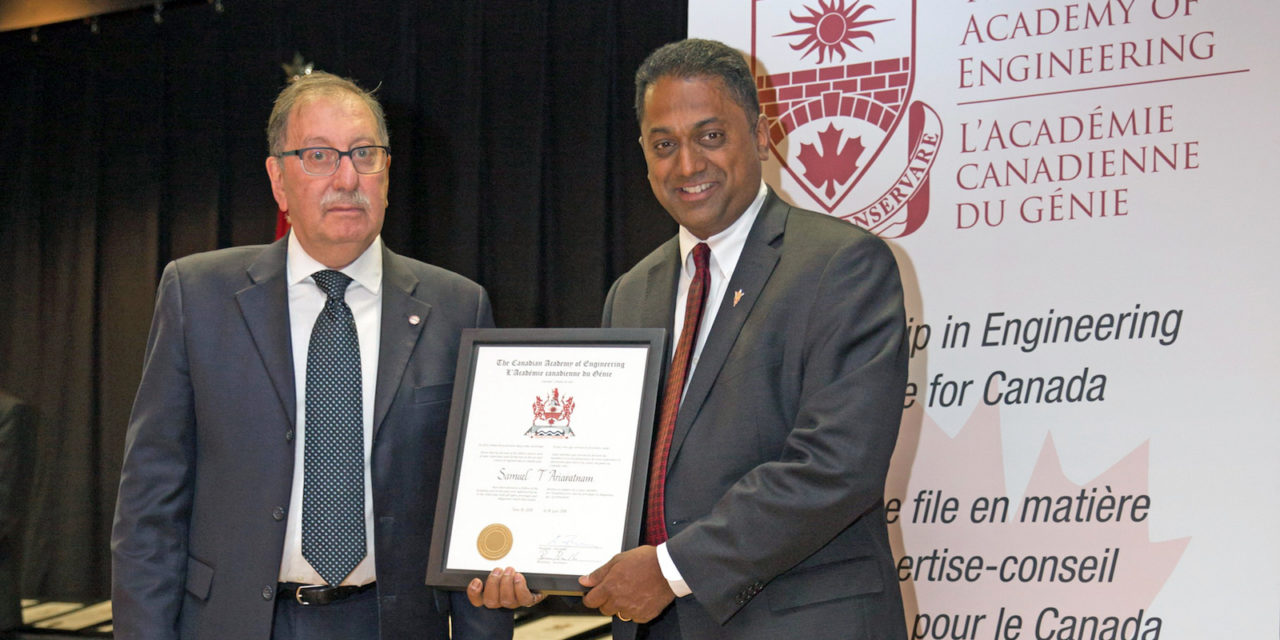
Above: Samuel Ariaratnam (right), Fulton Schools professor of construction engineering and management, is among new members of the Canadian Academy of Engineering. In addition to notable research, educational accomplishments and patent awards, Ariaratnam has been at the forefront of developing more economical, efficient and environmentally sensitive methods of building large underground infrastructure projects. Photo courtesy of the Canadian Academy of Engineering
Colleagues point out one particular admirable quality when describing Samuel Ariaratnam: He is the extreme opposite of a slacker.
Throughout his career Ariaratnam has “consistently demonstrated a tremendous capacity for hard work,” says Ray Sterling, a retired professor at Louisiana Tech University. He and Ariaratnam have been at the forefront of advancing trenchless technology methods in the construction engineering field.
Sterling and other longtime professional associates of Ariaratnam emphasize his impressive range of endeavors. Along with teaching, research and leadership roles in construction and engineering organizations, he is involved in industry consulting, advocacy for sustainable construction practices, mentoring students and training many of them for careers in his areas of expertise.
The impacts of those labors have meant a busy travel schedule for the professor of construction engineering and management in Arizona State University’s Ira A. Fulton Schools of Engineering. Ariaratnam is in demand throughout the United States and other countries for conference presentations, meetings with industry and government leaders and collaborations with fellow academics and researchers.
Those requests are likely to multiply in the wake of his most recent honor — being inducted to the Canadian Academy of Engineering.
Foremost authority on advanced construction techniques
The CAE is one of more than 25 members of the International Council of Academies of Engineering and Technological Sciences, which includes the National Academy of Engineering in the United States. The CAE inducts new members nominated by their peers for outstanding achievements in their fields and for significant contributions to leadership in their professions and to their communities.
Ariaratnam, a native of Canada, was lauded by the academy for research that has led to the development of new construction engineering technologies, the publication of more than 300 of his technical reports and research papers, co-authorship of eight textbooks and the five patents he has been awarded. Also noted were the two prestigious national awards for engineering contributions given to him by the American Society of Civil Engineers.
Foremost among his accomplishments, Ariaratnam has become a leading international authority on horizontal directional drilling and trenchless engineering applications.
Directional drilling is becoming popular as a more economical, efficient and environmentally sensitive method for installing infrastructure, including many types of pipelines and power and telecommunication cable conduits, especially infrastructure that crosses roads, waterways and congested urban environments.
Trenchless engineering and technology encompass the techniques, methods, materials and equipment that enable subsurface construction to be performed using fewer trenches than conventional underground construction and with minimal disruption to the surface.
Those advanced construction systems will be increasingly important as urbanization rapidly expands throughout the world, says says Edward Kavazanjian, an ASU Regents’ Professor and the Ira A. Fulton Professor of Geotechnical Engineering. Building underground infrastructure without the extensive surface disturbance caused by older construction methods will be critical to preserving the urban fabric of fast-growing cities, he says.
Elevating his field and communicating its value
Ariaratnam “is a true champion for the trenchless technology industry worldwide,” says Mary Andringa, who chairs the board of directors for the Vermeer Corporation, the leading manufacturer of horizontal directional drilling equipment.
The company has been one of Ariaratnam’s research partners for almost two decades and over that time Andringa says she has watched him “earn a high level of respect and credibility through his tireless work in support of the trenchless industry.”
As much as anyone in the field, Ariaratnam has “elevated it from a craft into a science-based discipline,” says Simaan Abourizk, who led the nomination of Ariaratnam for induction into the CAE.
Abourizk is a Distinguished University Professor, Canada Research Chair in Operation Simulation and chair of the Department of Civil and Environmental Engineering at the University of Alberta in Canada, where Ariaratnam held his first faculty position, beginning in 1996, and has since collaborated on research with Abourizk over the years.
Abourizk says Ariaratnam has risen to the top of his field not only by hard work but because of especially effective communications skills.
“He can connect with all kinds of people, and he’s very good at explaining our work to the public,” Abourizk says. “It’s an ability beyond what you typically find among many academics and researchers.”
University’s support crucial to research success
Ariaratnam credits much of his success to support he has received from ASU and the Fulton Schools.
“Faculty members are often incredibly busy with the combined responsibilities of teaching, research and professional commitments in their fields,” he says.
Particularly demanding are the voluminous administrative documentation and stringent criteria faculty members face in highly competitive quests to fund their research.
But “ASU and the Fulton Schools have provided excellent resources for faculty as we seek the larger, collaborative research grants,” Ariaratnam says. “Our research advancement team is first-rate and has enabled me to take on new research while keeping up with my current projects. We’re seeing the tangible results of this through the great success of the Fulton Schools in winning major research funding.”
Such support has helped give him time to focus on his additional role as chair of the construction engineering program in the School of Sustainable Engineering and the Built Environment, one of the Fulton Schools.
The program launched in 2010 and by 2016 had earned ABET academic accreditation, making it just one of 17 construction engineering degree programs in the United States with the most highly sought-after educational accreditation status.
There are now about 80 undergraduates and more than 50 graduate students in the program as it continues to grow, Ariaratnam reports, adding that “We could probably double our enrollment and still find jobs for all of our graduates.”
“Sam is an outstanding ambassador for our school,” says Professor Ram Pendyala, interim director of the School of Sustainable Engineering and the Built Environment. “His dedication to scholarship and his passion for educating the next-generation workforce is simply astounding. This recognition from the Canadian Academy is well-deserved. We consider ourselves very fortunate to have Sam on our faculty.”
Reaching prominent position among peers
Ariaratnam was a 1989 civil engineering graduate of the University of Waterloo, close to where he grew up in the town of the same name about 60 miles southwest of Toronto and where his father taught in the civil engineering department for four decades.
He went on to earn master’s and doctoral degrees at the University of Illinois at Urbana-Champaign, concentrating on studies in construction engineering. After teaching at the University of Alberta, he joined ASU in 2001. He has since served terms as the chair of the American Society of Civil Engineers Pipelines Division and the International Society for Trenchless Technology and on two committees of the National Academies of Sciences, Engineering and Medicine.
Induction into his home country’s engineering academy “is a real honor,” and considering the stature of some of the other new members — four of them are deans of engineering schools — “it was also a bit of shock,” Ariaratnam says, but a good kind of shock.
He joins one other CAE member at ASU, Sethuraman Panchanathan, executive vice president of Knowledge Enterprise Development, the university’s chief research and innovation officer and a Fulton Schools professor.


